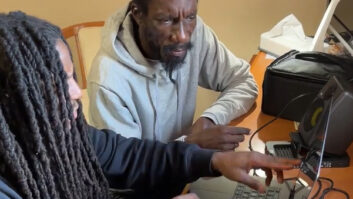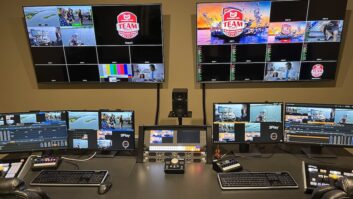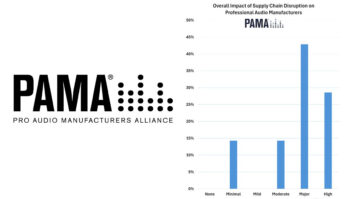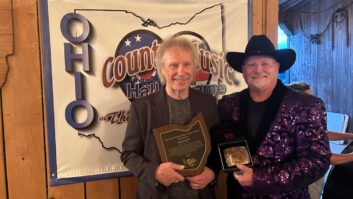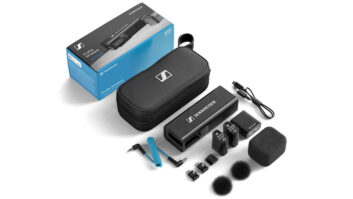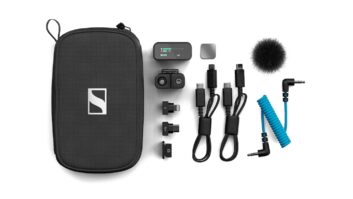Podcasting in a pandemic is no simple feat. The podcasting world has stepped up to keep audiences informed with daily news bites and in-depth coverage of the global COVID-19 pandemic—but not everyone wants a deep dive on coronavirus after weeks of sheltering in place. Luckily for those listeners, escapism is also just a podcast away as major podcasters bring on new gear and revamp production workflows to keep the content coming.
 “The news cycle can really wear people out,” says Chris Bannon, chief content officer at Stitcher. “If a [podcast] host has a perspective or passionate idea about the virus that will resonate with listeners, we’ll do everything we can to make it happen. But lots of listeners need a break from that.”
“The news cycle can really wear people out,” says Chris Bannon, chief content officer at Stitcher. “If a [podcast] host has a perspective or passionate idea about the virus that will resonate with listeners, we’ll do everything we can to make it happen. But lots of listeners need a break from that.”
Podcats like Comedy Bang! Bang! and Conan O’Brien Needs a Friend are bringing comic relief to people looking for a laugh. LeVar Burton, the former host of the beloved children’s television show Reading Rainbow, has been comforting audiences in a different way—by reading to them.

“Some hosts have really connected with fans via live streaming video,” notes Bannon. “LeVar Burton brought LeVar Burton Reads to Twitter livestream, and more than 900,000 people tuned in,” resulting in a 15 percent growth of his podcast audience. “He’s the kind of person listeners turn to for comfort, inspiration and companionship—all the stuff that podcasting does really well.”
While staffers shelter in place, production of Stitcher originals like LeVar Burton Reads and Science Rules! With Bill Nye have moved off-campus from Stitcher’s studios in Los Angeles and New York, where producers normally have audio consistency due to the use of Shure SM7B microphones and Allen and Heath Qu series mixers in every room.
“Our hosts and guests can record in any of the rooms and maintain a consistent sound,” says Jared O’Connell, director of engineering at Stitcher. “There are subtle differences in how each room sounds, just because of the acoustic treatment and shape of the room, but generally speaking, it allows us to record anything in any room without much difference in the quality of the sound.”

Until employees can return to their workplaces, Stitcher’s team has set up many of their hosts and regular guests with home recording equipment, including cardioid dynamic vocal mics like the Samson Q2U and Sennheiser Handmic Digital, and audio interfaces from Focusrite. Some hosts already had portable recorders like the Zoom H5 and H6, which have proven handy for recording multiple voices to individual tracks.
“The tech director for Freakonomics Radio has been shipping recording kits to guests so he can get good tape during their interviews,” says O’Connell. “That’s usually a USB microphone, a set of decent-quality headphones, and a reflection filter that wraps around the back of the microphone.” Reflection filters essentially act as a mini vocal booth, minimizing audio reflections in spaces that aren’t acoustically treated.
Stitcher isn’t new to long-distance podcast recording, though. Producers already use platforms like Source-Connect Now and the cloud to communicate between the Los Angeles and New York studios, while syncing audio during post production. The company has also added Zoom and Skype to that list in the near term, O’Connell says.
 Parcast, an original content production house acquired by Spotify in 2019, built its reputation by producing a high volume of content with a focus on the true crime genre. Parcast, which produces Today in True Crime and Espionage, adheres to robust daily and weekly schedules instead of the season-based model.
Parcast, an original content production house acquired by Spotify in 2019, built its reputation by producing a high volume of content with a focus on the true crime genre. Parcast, which produces Today in True Crime and Espionage, adheres to robust daily and weekly schedules instead of the season-based model.
“We’ve always focused on volume—we look for stories and genres that will lend themselves to making 500 episodes,” says Parcast founder Max Cutler.
The pandemic has changed parts of Parcast’s workflows as, similar to Stitcher, a few hosts have set up makeshift recording booths at home, but other aspects have stayed the same, according to senior production lead Ron Shapiro.
“The final mixdown and production of our podcasts hasn’t changed very much,” says Shapiro. “Parcast has always utilized an international team of sound designers. In essence, we have been working from home since the founding of Parcast.” Using multi-track Cleanfeed, the host records their parts locally and then uploads the file to the cloud, where a sound designer grabs the file, produces the episode and uploads the final mix.
“When we transitioned to shelter-in-place recording, a few of our hosts already had home studios,” says Cutler. “If they did not, we were able to get them the equipment they needed to continue the recording cadence they would have had in the studio.” The production house set up those hosts with Røde Rødecaster Pro mixers and NTG1 microphones.
Producing Rolling Stone’s Podcast During COVID-19
Notes Shapiro, “The Rødecaster works very well, because you can connect your phone or laptop to it [and] hear the co-host and producer without loopback of their audio. You can also record internally with the push of one big ‘record’ button, so you don’t need to know how to use a digital audio workstation such as Pro Tools.”
Producers at Stitcher, Parcast and likely other podcasting houses are paying close attention to their current arrangements and solutions, adjusting their workflows to maintain consistency and planning for the future.
“We’re seeing many of the strengths of this medium on full display right now: the scrappiness, innovation and creativity of our hosts, [our] nimble production capabilities and the deep audience trust,” says Bannon.
“They’re all at work to inform our audiences, keep them entertained and provide some levity as we all weather this pandemic. We believe those same strengths will become even more clear as we emerge on the other side.”

